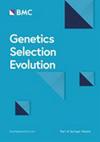利用全基因组 SNP 数据研究加那利山羊品种的人口历史和对环境条件的适应性
IF 3.6
1区 农林科学
Q1 AGRICULTURE, DAIRY & ANIMAL SCIENCE
引用次数: 0
摘要
加那利群岛山羊的出现可以追溯到公元前一千年晚期,与阿马齐格定居者的殖民时期相吻合。然而,加那利山羊的确切地理起源并不确定,因为阿马齐格人的分布范围很广。如今,三个加那利山羊品种(Palmera、Majorera 和 Tinerfeña)以及两个不同的南 Tinerfeña 和北 Tinerfeña 生态型已得到官方认可,其中南 Tinerfeña 和 Majorera 山羊生长在干旱和干燥的半沙漠环境中,而 Palmera 和北 Tinerfeña 山羊则适应于受信风影响的潮湿和温带地区。利用 Illumina 山羊单核苷酸多态性 (SNP)50 BeadChip 生成了 224 只加那利山羊的基因型。通过将这些数据与 1007 个非洲和南欧血统个体的基因型合并,我们的目的是确定加那利山羊的地理起源,并找出与适应不同环境条件相关的基因。除了帕尔梅拉山羊的遗传变异水平较低之外,加那利山羊品种的多样性指数与所分析的非洲和欧洲地方品种的大多数指数一致。与其他种群相比,加那利山羊的遗传分化明显,这表明其曾长期处于地理隔离状态。此外,系统发育重建表明,加那利山羊的祖先基本上是北非人,而不是西非人。ADMIXTURE 和 TreeMix 分析表明,没有证据表明加那利山羊与其他大陆品种之间存在基因流动。同源性分析(ROH)发现了 13 个 ROH 岛,而基于窗口的 FST 方法则发现了 25 个受选择的基因组区域。通过各种比较和方法,在 Capra hircus(CHI)的 6、7 和 10 号染色体上发现了主要的选择信号。这项全基因组分析为研究居住在加那利群岛的四个品种的进化史提供了新的线索。我们的研究结果表明,加那利山羊起源于北非。此外,在 ROH 和 FST 方法所强调的基因组区域内,还发现了几个与体型和耐热性有关的基因。本文章由计算机程序翻译,如有差异,请以英文原文为准。
The demographic history and adaptation of Canarian goat breeds to environmental conditions through the use of genome-wide SNP data
The presence of goats in the Canary Islands dates back to the late 1st millennium BC, which coincides with the colonization by the Amazigh settlers. However, the exact geographic origin of Canarian goats is uncertain since the Amazigh peoples were distributed over a wide spatial range. Nowadays, three Canarian breeds (Palmera, Majorera and Tinerfeña) are officially recognized, along with two distinct South and North Tinerfeña ecotypes, with the South Tinerfeña and Majorera goats thriving in arid and dry semi-desertic environments and the Palmera and North Tinerfeña goats are adapted to humid and temperate areas that are influenced by trade winds. Genotypes for 224 Canarian goats were generated using the Illumina Goat single nucleotide polymorphism (SNP)50 BeadChip. By merging these data with the genotypes from 1007 individuals of African and Southern European ancestry, our aim was to ascertain the geographic origin of the Canarian goats and identify genes associated with adaptation to diverse environmental conditions. The diversity indices of the Canarian breeds align with most of those of the analyzed local breeds from Africa and Europe, except for the Palmera goats that showed lower levels of genetic variation. The Canarian breeds demonstrate a significant genetic differentiation compared to other populations, which indicates a history of prolonged geographic isolation. Moreover, the phylogenetic reconstruction indicated that the ancestry of the Canarian goats is fundamentally North African rather than West African. The ADMIXTURE and the TreeMix analyses showed no evidence of gene flow between Canarian goats and other continental breeds. The analysis of runs of homozygosity (ROH) identified 13 ROH islands while the window-based FST method detected 25 genomic regions under selection. Major signals of selection were found on Capra hircus (CHI) chromosomes 6, 7, and 10 using various comparisons and methods. This genome-wide analysis sheds new light on the evolutionary history of the four breeds that inhabit the Canary Islands. Our findings suggest a North African origin of the Canarian goats. In addition, within the genomic regions highlighted by the ROH and FST approaches, several genes related to body size and heat tolerance were identified.
求助全文
通过发布文献求助,成功后即可免费获取论文全文。
去求助
来源期刊

Genetics Selection Evolution
生物-奶制品与动物科学
CiteScore
6.50
自引率
9.80%
发文量
74
审稿时长
1 months
期刊介绍:
Genetics Selection Evolution invites basic, applied and methodological content that will aid the current understanding and the utilization of genetic variability in domestic animal species. Although the focus is on domestic animal species, research on other species is invited if it contributes to the understanding of the use of genetic variability in domestic animals. Genetics Selection Evolution publishes results from all levels of study, from the gene to the quantitative trait, from the individual to the population, the breed or the species. Contributions concerning both the biological approach, from molecular genetics to quantitative genetics, as well as the mathematical approach, from population genetics to statistics, are welcome. Specific areas of interest include but are not limited to: gene and QTL identification, mapping and characterization, analysis of new phenotypes, high-throughput SNP data analysis, functional genomics, cytogenetics, genetic diversity of populations and breeds, genetic evaluation, applied and experimental selection, genomic selection, selection efficiency, and statistical methodology for the genetic analysis of phenotypes with quantitative and mixed inheritance.
 求助内容:
求助内容: 应助结果提醒方式:
应助结果提醒方式:


